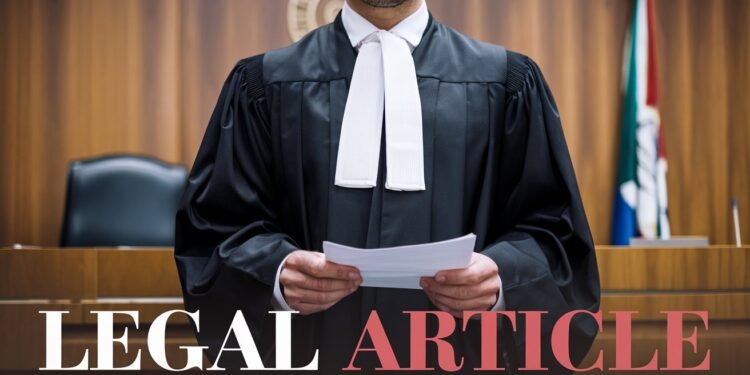Author Gauri Sharma from Guru Gobind Singh Indraprastha University, Delhi
INTRODUCTION
Justice, the core need of the society, is one of the most impactful and important elements of the social and political structure. Everybody perceives justice a little differently according to their own whims and fancies but the term justice literally means the rule of law or righteousness. According to Aristotle, “Justice is comprised of what is legal and fair, whereas fairness refers to the unbiased distribution and the faultlessness of what is unequal. Justice is no less important to him, as he regards it as the very virtue of the state. It is justice that creates a state, gives it a vision, and, when combined with ethics, propels the state to the pinnacle of all ethical values.” To a common man, justice is being able to fight for their own rights and being able to take help of the law if they are wronged. Justice to have a free and fair trial and to be heard in the court of law.
The criminal justice system, vital for combating crime and ensuring justice in society, is comprised of three key components: investigation, inquiry, and trial as per the procedural law, Code of Criminal Procedure, 1973 (Cr.P.C)
.Investigation is the first and foremost step of the criminal procedure for justice. Investigation is defined under Section 2 (h) of Cr.P.C which states “all the proceedings under this Code for the collection of evidence conducted by a police officer or by any person (other than a Magistrate) who is authorised by a Magistrate in this behalf”. Criminal Investigation is a systematic and thorough process towards establishing the actual criminal activities, by trained law enforcement personnel. It consists of steps that are used to acquire and evaluate evidence, identify potential suspects, and verify the truth of a case from which justice is rooted.
Criminal investigations are individualized and follow the purpose of identifying if a crime happened, who did it, and finding out all necessary evidence to hold them accountable in a court subsequently. There are two major components of protecting rights: legal standards and due process. Criminal Investigations are conducted under an established body of legal rules designed to protect individual rights and keep the evidence from being improperly collected or handled. Magistrate is a judicial body whose aim is to ensure that the due process of law is followed throughout the investigation. The magistrate acts as a bridge between the law enforcement agencies and the judiciary. A magistrate during an investigation focuses on how there should be no illegal methods used during the investigation either to extract information or tampering any evidence.
Through this article we will be understanding the role of the magistrate in investigation.
Legal Framework Governing Magistrate’s Role in Investigation
The term Magistrate, though not defined, refers to a judicial officer who overlooks the investigation process during a criminal case. The powers and duties of a magistrate during an investigation are primarily governed by the judicial procedure of the Code of Criminal Procedure (Cr.P.C)
Case Law: All India Judges Association vs. Union of India Justice Rangnath Mishra observed that “the Trial judge is the kingpin in the hierarchical system of administration of justice. He directly comes in contact with the litigant during the proceedings in court. On him lies the responsibility of building up the case appropriately and on his understanding of the matter the cause of justice is first answered.”
The significance of a Trial Judge was appropriately outlined by the Supreme Court in the Ram Chander v. State of Haryana case by stating that: “If a Criminal Court is to be an effective instrument in dispensing justice, the presiding judge must cease to be a spectator and a mere recording machine. He must become a participant in the trial by evincing intelligent active interest by putting questions to witnesses in order to ascertain the truth.”
|
Sections |
Type of Magistrate |
Sentence |
|
Section- 9 |
Court of Session |
Any sentence deemed appropriate, would require the high court’s approval for death sentence |
|
Section- 12 |
Chief Judicial Magistrate |
Any sentence for more than 7 years except for death sentence or life imprisonment |
|
Section- 11 |
Judicial Magistrate First class |
A sentence of imprisonment for less than 3 years or affine less than 10 thousand rupees or both. |
|
Section- 11 |
Judicial Magistrate Second Class |
A sentence of imprisonment for less than 1 years or affine less than 5 thousand rupees or both. |
|
Section- 20 |
Executive Magistrate |
Role of Magistrate in Investigation
Understanding the role of a magistrate involves recognizing four key stages
Stage 1- Section 156(3) of Cr.P.C (Investigation of a Cognizable crime)
When details of a cognizable offense are reported, an FIR must be lodged as per section 154 of Cr.P.C. Following this, a police inquiry should be conducted under section 156 of CrPC, granting a police officer the authority to initiate an investigation into a cognizable crime without magistrate approval. Section 156(3) allows any magistrate defined in section 190 to direct the police to investigate if they have not filed a First Information Report (FIR) after being notified of a cognizable offense.
In Pala Singh vs. State of Punjab the Supreme court mentioned that “the Magistrate himself can take cognizance of an offence under section 190 (1)(a).” A magistrate under section 202 of Cr.P.C can postpone the issue of process if he deems fit to carry out a further inquiry in a given case and can order a direct investigation for the police to ascertain the truthfulness of the complaint. The contrast between police investigations under Sections 156(3) and 202 lies in the fact that, in the former, the investigation must start fresh on the entire issue, whereas in the latter, the investigation is limited and focused on a specific area.
Additionally, a probe is conducted under Section 156(3) to determine if there is any evidence that can be used to issue summonses. The investigation is not seen as concluded and may undergo additional examination.
In Sakari Vasu vs State of UP (2008) The Supreme Court has clarified that the phrase “order an investigation” includes all additional powers needed for a successful investigation. The judge has the authority to oversee the investigation.
In Madhav Singh vs State of UP the Allahabad High Court examined the evidence presented in the case and evaluated whether the trial court’s judgment was legally sound. Key principles typically addressed in such cases include the sufficiency and reliability of evidence, adherence to legal procedures, and whether the conviction was based on a correct interpretation of the law. The court’s decision was based on its assessment of the trial court’s handling of the case, including evaluating whether there were any substantial errors that would warrant overturning the conviction. The case underscores the role of higher courts in reviewing judgement of lower courts to ensure justice and proper application of the law.
Delhi High Court rules (vol III, chapter II, part A, rule 4) laid down that, “in case of a heinous case like murder, FIR should be sent to the magistrate immediately in his court during court hours and at his residence thereafter, after this magistrate require to make a note regarding date/time and place of receipt on the report which was received by him”
Stage- 2 Remand of an accused person
The arrest procedure should be non- arbitrary, just and reasonable. Section 167 of Cr.P.C states that “if a person is arrested and detained in custody and it appears that the investigation cannot be completed” in 24 hours (as prescribed in section 57), the police officer shall seek the judicial magistrate’s approval for the same. It is upon the discretion of the judicial magistrate whether he grants police custody (PC), judicial custody (JC) or releases the accused on bail.
If the arrest is not according to section 41 of Cr.P.C. then there cannot be any authorised detention. In the case of Arnesh Kumar vs. The State of Bihar the supreme court held that “a magistrate should record its own satisfaction before authorising detention and should not follow the ipse dixit of the police”. In instances involving juveniles, officers may intentionally misrepresent their age as over 18 to avoid the specific provisions of the Juvenile Justice Act. In order to address this issue, the Delhi high court ruled that if the suspect is between 18 and 21 years old, the investigating officer must gather evidence of age and create an age memo. The court may also inquire about the age if the suspect requests it
Stage -3 Recording of statement
Section 164 of Cr.P.C. allows testimony of witnesses to be recorded before the magistrate on oath, in a test identification parade (TIP). The judge has to ensure that the defendant wears a mask in court and their identity remains undisclosed to the witness. The judge must also make sure that the witness does not see the accused’s photo before the identification parade to avoid influencing the outcome. When collecting handwriting/signature samples or administering narco-analysis during an investigation, it is crucial for the judge to ensure that correct legal protocols are followed.
In Rabindra Kumar Pal alias Dara Singh v. Republic of India (2011), a notable case from the Supreme Court of India that dealt with serious criminal charges, including the murder of christian missionaries and their family members. In its judgment, the Supreme Court of India upheld Dara Singh’s conviction and the death penalty imposed by the lower courts. The Court found that the evidence against Dara Singh was overwhelming, including witness testimonies and forensic evidence, which substantiated the charges of murder, conspiracy, and other serious offenses. The court also emphasized that the brutal nature of the crime and its impact on the victims and their families warranted the death penalty. It reinforced the application of capital punishment in cases of heinous crimes, particularly when there is clear and compelling evidence of guilt.
Stage-4 Further Investigation
Court is not constrained to dope out the conclusion given by the police after leaving the inquiry. In Gangadhar Janardan Mhatre v. State of Maharashtra it was held by the supreme court that “in those cases where after said investigation police came to a conclusion and reported that there is no case against accused informant has right for notice an opportunity of hearing before the court at time when his report will be considered”.
To recall, under Section 173 of Cr.P.C., there is an option for a magistrate to order further investigation but this section does not specify the circumstances which may guide such power exercise by Magistrate. In Kashmeri Devi vs Delhi Administration it was held that a magistrate can in his opinion direct further investigation where police action is not impartial or they shield the offenders.
Further consideration in Vinay Tyagi v. Irshad Ali, the court established several additional assessments to examine. The court stated that the outcome of the additional inquiry is referred to as a “supplementary report,” which can contribute to the original police report, but past investigations must not be completely disregarded. The magistrate cannot instruct a different agency to conduct additional investigation beyond the initial investigating agency.
DUTIES AND RESPONSIBILITIES OF A MAGISTRATE
Supervising of police investigation
The magistrate is responsible for overseeing police investigation to ensure lawful conduct and fairness of trial without any prejudice. This includes reviewing case diaries, monitoring the investigation process, looking after any complaint regarding police misconduct or bias.
Issuance of warrant
One of the significant duties of a magistrate is to issue search and arrest warrants. These warrants are issued on careful consideration of the evidence presented by the investigating officers. It is the duty of the magistrate to ensure that the warrants are specific and justified.
Remand and custody decision
Magistrate plays a key role in deciding whether an accused should be remanded in police custody or judicial custody. The decision is made after considering the nature of offense, the progress of investigation and the rights of the accused.
Recording of statement
Statements recorded under oath can be crucial evidence in the subsequent trial. The magistrate ensures that these statements are recorded voluntarily, without any coercion, and in a manner of legal protocol.
Ordering medical examinations
In cases involving allegations of physical or sexual abuse, the magistrate ensures that the medical examinations are conducted by qualified professionals and that the dignity and rights of the individuals involved are respected.
CONCLUSION
A magistrate’s role in investigations is indispensable in the criminal justice system. Being a pillar for the society against potential abuses of power by law enforcement, magistrates ensure that investigations are being proceeded lawfully, fairly and keeps in mind about the integrity of the judicial process. Their oversight functions are vital to maintaining the balance between effective law enforcement and a common man in need for protection of its rights and liberties.
REFERENCES
Mehrotra, A. (2023). INDIAN JOURNAL OF CRIMINOLOGY VOLUME 50(1) 2022. ResearchGate. https://www.researchgate.net/publication/366740554_INDIAN_JOURNAL_OF_CRIMINOLOGY_VOLUME_501_2022?enrichId=rgreq-bc724b5908a347c994e83401c4a3208c-XXX&enrichSource=Y292ZXJQYWdlOzM2Njc0MDU1NDtBUzoxMTQzMTI4MTExMDQ2NTU0OEAxNjcyNTY4Mzc0MTk0&el=1_x_2&_esc=publicationCoverPdf
Rai, D. (2020, September 7). What is the role of a Magistrate in a criminal investigation – iPleaders. iPleaders. https://blog.ipleaders.in/what-is-the-role-of-a-magistrate-in-a-criminal-investigation/
Admin. (2022, April 30). JUSTICE: MEANING AND ITS IMPORTANCE – JLRJS. JLRJS. https://jlrjs.com/justice-meaning-and-its-importance/



